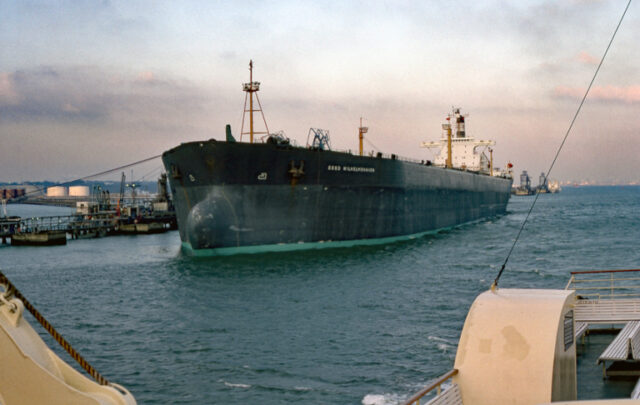The smooth, prompt start-up of about a dozen big-ticket oil projects over the next 18 months is more important than ever to meeting global oil demand growth and keeping prices under control, analysts say.
These multi-million-dollar oilfield and pipeline plans should deliver 2.4 million barrels per day (bpd) of new production capacity before the end of 2005, mostly in non-OPEC areas such as the former Soviet Union, Brazil and West Africa, a Reuters survey found.
A host of second-tier developments adds more than one million bpd.
Delays to a few of these fields could propel oil’s five-year price boom to new highs, with demand growth galloping at its fastest rate in 24 years and OPEC pumping closer to its own capacity than any time in more than a decade.
“The diminishing cushion of surplus capacity within OPEC means that there is real need for these big non-OPEC projects to come through,” said Steve Turner of Commerzbank.
Just a few months ago analysts saw 2005 as a major test for OPEC, with a burst of new oil from non-cartel countries stealing market share. Now, the test is whether OPEC and other producers will be able to pump enough oil to keep up with consumption.
Driven by China’s economic expansion, oil demand growth this year has surged an estimated 2.3 million bpd, while the rise in non-OPEC output will lag that substantially at only 1.2 million bpd, the International Energy Agency says.
Analysts expect average non-OPEC supply growth of around 0.8-1.4 million bpd next year, still likely to fall short of an estimated 1.5-2.0 million bpd rise in demand.
“The global oil industry has been caught out by two consecutive years of oil demand growth above two percent and production capacity has not risen fast enough to meet increased demand while maintaining a buffer of spare capacity,” the Centre for Global Energy Studies said.
The shortfall in capacity growth next year has added a heightened sense of urgency for new fields to deliver on-time oil — or risk a shortage.
The Organisation of the Petroleum Exporting Countries is now producing crude to within one to two million bpd of its maximum, or less than three percent of the 80 million bpd world market, analysts estimate.
With such a small margin of error, relatively minor supply hiccups can have a major impact on oil prices, which a month ago soared to 21-year peaks over $40.
Major outages like the Iraqi pipeline sabotage in June and last week’s Norwegian strike have kept the market on edge.
“Had these disruptions lasted for months, as opposed to days, there would likely not have been enough excess capacity available worldwide to make up for the total loss of exports, resulting in upward price pressure,” the U.S. Department of Energy said in a weekly report.
“Since capacity expansion involves substantial investment and long lead times, minimal spare capacity for the mid-term appears likely, barring a significant decline in oil demand growth.”
SOME PROJECTS PRONE TO DELAYS
The 11 mega-projects of more than 150,000 bpd expected onstream before the end of next year are heavily concentrated in the former Soviet Union, Brazil and West Africa, a Reuters survey found.
International oil majors have focused on big projects as a drive to improve profit margins force them into frontier areas to find the big fields that bolster profits.
These emerging provinces have already suffered setbacks and delays.
Shell’s flagship 225,000 bpd Bonga field in Nigeria has already been pushed back by more than a year and will now start up “well into” 2005, while Brazil’s numerous offshore platforms have also suffered repeated delays.
Russian and Caspian production growth depends heavily on three near-term pipeline projects bringing the oil to market, one of which still needs government approval.
More than three-quarters of the new mega-projects will launch next year, with the majority delivering peak flows quickly since they are largely pipeline or offshore developments.
Including smaller developments, more than 3.5 million bpd of capacity at platform should be started up next year, up from 2.5 million bpd this year, according to Robert Skinner, director of the Oxford Institute of Energy Studies.
The estimates of new capacity next year are much higher than forecasts for non-OPEC production growth, which averages output over the year and takes into account declining production from mature basins like the North Sea, where production fell six percent last year.
CRUNCH MAY EASE
While the capacity crunch is big news now, there is no certainty it will last. OPEC’s own capacity should increase in the medium-term, analysts say, while a near-term fall in prices should also take some of the pressure off.
“We believe there will be a significant price decline in the next six to 12 months,” said Sarah Emerson of Boston-based Energy Security Analysis. “At that point the nervousness over tight spare capacity will drop off because OPEC is likely to cut back.”
Nigeria and Saudi Arabia have big plans in the works in the next 18 months, but the real expansion should come from 2006 onward, analysts say.
Geoff Pyne, consultant for Sempra Energy, estimates cartel capacity, which stagnated around 30-32 million bpd for the past seven years, will climb to 35 million bpd by 2006.
Saudi Arabia has said it could raise its sustainable capacity by as much as four million bpd if demand warranted it, but says the 800,000 bpd of new oil from Qatif and Abu Safah flowing from October is only meant to offset intentional declines in older fields.
Libyan production is likely to get a fillip from the post-sanctions return of U.S. firms to frozen assets, while the United Arab Emirates, Iran and Nigeria all have projects in the works in several years’ time.
Iraq holds the world’s second-largest oil reserves and could probably ramp up production relatively quickly, but the massive investment necessary for that still appears years away.





